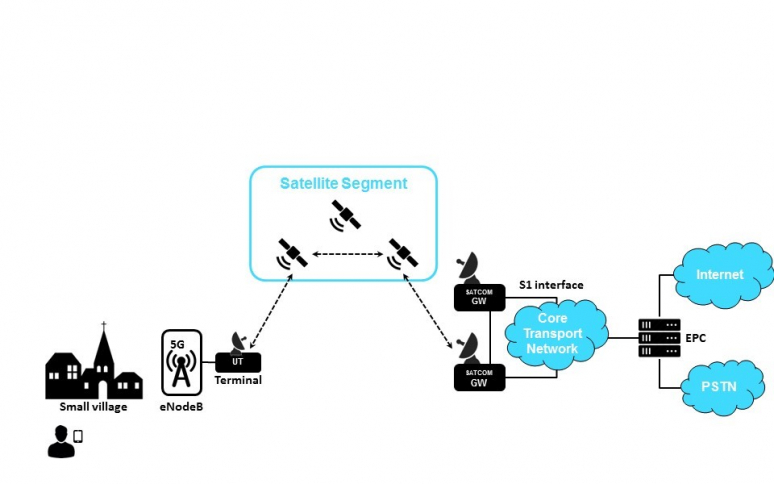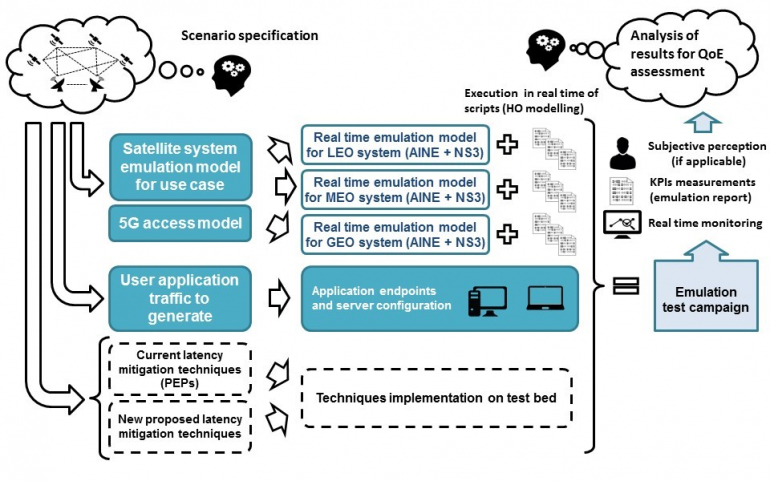-
StatusCompleted
-
Status date2024-06-14
-
Activity Code1B.118
The project considers different reference GEO and non-GEO satellite systems (MEO and LEO, with and without inter-satellite links) and a set of relevant user applications & services (for broadband access and 5G backhauling), with the following main objectives:
- To characterize and compare quantitatively the Quality of Experience (QoE) that can be achieved with the current baseline technology for the different scenarios, identifying performance gaps,
- To identify and analyze satellite network technology evolutions that can mitigate the effect of satellite latency in the user QoE and assess performance benefits,
- Based on the identified key technology gaps, make recommendations to standardisation bodies and other groups (3GPP, ETSI…) and define a roadmap regarding future technology developments and standardisation needs
The project focuses on applications that are likely to be prevalent in the 2025 time horizon and that may be especially latency sensitive (e.g., gaming, cloud services or 360º video-on-demand). These applications are being increasingly encrypted, rendering some of the traditional latency mitigation techniques ineffective.
One of the challenges of the project is to handle a relatively high number of evaluation scenarios and test cases adequately and to obtain representative QoE results. Another challenge is to identify properly the potential of technologies that can improve the QoE, by using an emulation test bed and real applications.
The project provides the following benefits:
- A reference regarding the QoE that can be obtained by different satellite systems and relevant current & future applications. This reference can be used to promote the use of satellite among relevant entities (e.g., within 5G), but also to identify competitiveness issues with respect to terrestrial technologies.
- A set of promising latency mitigation techniques. Once they are fully developed, these techniques may create market opportunities, maintain satellite competiveness and support the integration of satellite systems in the 5G eco-system.
- Recommendations to standardisation bodies and other groups with the aim to promote the use of satellite communications.
The project defines a set of system scenarios composed by the combination of satellite access networks (in all the range of orbit heights, covering GEO, MEO, LEO without ISL and LEO with ISLs) and two transport services: broadband Internet access and 5G cell backhauling. These scenarios also include Performance Enhancement Proxies (PEPs).

Satellite scenario with 5G backhauling
For each scenario, a set of applications is selected, whose Quality of Experience is quantitatively evaluated through a set of Key Performance Indicators (KPI). For this purpose, the project implements a real-time emulation test bed, which provides a realistic modelling of the different satellite system reference scenarios and, when applicable, the 5G access network. This test bed is used with real applications, using a combination of real and replicated servers.
Measured KPIs are benchmarked against the 5G terrestrial network reference. Then, the project identifies and evaluates technology solutions that can improve KPIs and eventually act as enabler of certain applications.
There is also an assessment of the impact of these solutions on the affected elements in the satellite systems, with recommendations on a roadmap towards implementation.
The project also produces recommendations to standardization entities (mainly 3GPP and ETSI) about including satellite networks as transport networks compliant with 5G requirements.
The following figure depicts the high-level architecture of the emulation testbed that is used for KPI measurements and technology evaluation.

High-level architecture of the emulation test bed
The diagram shows application endpoints and servers, which may be either locally replicated servers or real servers to be accessed through the Internet. Considered applications are:
- Web services (including HTTP/2 and QUIC)
- Streaming services (including 360º VoD)
- Online gaming
- Cloud virtual desktop services
- IoT backhauling
Application traffic passes through different emulators that model the reference satellite systems (implemented using Indra’s AINE tool) and 5G networks (implemented using NS-3). The satellite system emulator is configured to model the propagation delays of the different GEO and non-GEO satellite systems, delay variations due to handovers and the effects of satellite radio resource management (bandwidth on demand protocols).
The test bed includes also some middleware (PEPs) that implements current latency optimization techniques
The project is structured into four main sequential tasks:
- Definition of satellite scenarios and applications, the tests to be performed, the organization and the test environment, including emulation tools, applications and KPIs to measure (PR1 milestone).
- Test bed development, verification and validation. Tests execution and KPIs benchmarking in the scenarios baseline configuration with 5G terrestrial networks (MTR milestone).
- Investigation of potential latency mitigation techniques to close the gap between satellite and terrestrial 5G networks. Test bed and benchmarking update (PR3 milestone).
- Generate recommendations on the technologies to implement for satellite 5G networks, define a technology roadmap and contribute to standardisation fora (PR4 milestone).
After successful finalization of the Final Review, the project is now completed. Under request, a set of reports is available explaining the main outcomes of the QoE evaluation campaign and describing the proposed mitigation techniques and related evaluation results.
An extension of the project has started that addresses specifically the performance problems encountered when using QUIC over satellite links, with the objective to participate as necessary in IETF QUIC standardisation groups so that the specific characteristics of satellite links are taken into account as much as possible.






